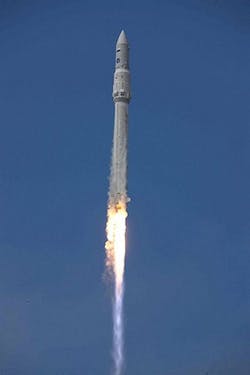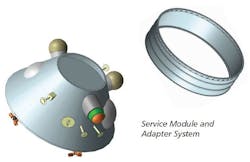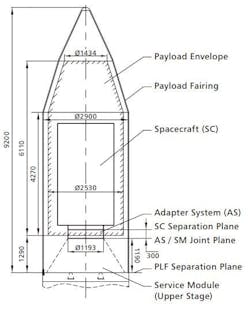International Launch Services wins first Angara 1.2 commercial satellite launch contract
The Angara 1.2 vehicle is the newest Russian launch vehicle, designed and built by Khrunichev State Research and Space Production Center (Khrunichev), serving the small- to medium-range satellite market, with the capability to launch up to 3.5 metric tons to low-Earth orbit (LEO) or sun-synchronous orbit (SSO). Angara 1.2 will launch the KOMPSAT-6 mission into an SSO orbit.
Flight tests of the Angara vehicle family began in 2014 from the Plesetsk Cosmodrome. The first test flight of the Angara 1.2 light class vehicle was conducted on 9 July 2014, followed by the first launch of the Angara 5.1L heavy lift vehicle on 23 December 2014.
KOMPSAT-6, with an estimate separated mass over 1.7 metric tons, will be equipped with a synthetic aperture radar (SAR) developed and manufactured in cooperation with the domestic Korean industry. KOMPSAT-6 will be mounted with a SAR with sub-meter resolution, which is a follow-on satellite of KOMPSAT-5.
“The selection of the ILS Angara 1.2 vehicle for the launch of KOMPSAT-6 was carefully considered for performance, heritage, price, and schedule assurance. We have the utmost confidence in ILS, Khrunichev, and the Angara launch vehicle and look forward to our continued cooperation in space activities with ILS and Khrunichev with the KOMPSAT-6 launch,” says KARI President Dr. Gwang-Rae Cho.
“The Angara 1.2 launch vehicle is ideally suited for launch of KOMPSAT-6 by providing KARI with both schedule assurance and optimal mission performance,” says ILS President Kirk Pysher. “ILS and Khrunichev welcome the opportunity to support this important mission for KARI, furthering the international cooperation between our organizations.”
“This was a challenging competition for KOMPSAT-6 as we were bidding against a very strong field of commercial launch service providers,” explains Thomas Carroll, ILS vice president of sales. “ILS was selected under KARI’s extensive review process based on many factors. This confirms our position in the launch market segment as a preferred launch service provider. ILS’ 23 years of commercial launch service experience at the Baikonur Cosmodrome will serve customers well as we support Angara 1.2 launch services from the Plesetsk Cosmodrome.”
ILS provides launch services for global satellite operators and offers an array of services and support, from contract signing through mission management and on-orbit delivery. ILS has exclusive rights to market the Proton and Angara vehicles to commercial satellite operators worldwide and is a U.S. company headquartered in Reston, Va. To date, ILS has launched 93 commercial missions.
Khrunichev holds the majority interest in ILS and is one of the cornerstones of the Russian space industry.
Khrunichev, part of the Roscosmos State Corp., is the developer and manufacturer of the Proton and Angara launch vehicle families. The Proton vehicle launches from facilities at the Baikonur Cosmodrome in Kazakhstan, and has a heritage of more than 410 missions (in various evolutions) since 1965. Khrunichev includes a number of key manufacturers of the Proton launch vehicle located in Moscow and in other cities of the Russian Federation.
The Angara Launch Vehicle Family
Angara is a family of advanced and environmentally friendlier launch vehicles with light to heavy lift range developed around Universal Rocket Modules (URM). Different configurations of Angara launch vehicles are declined with various numbers of URM 1 and URM 2 modules. The Angara family of vehicles has a modular structure to support a wide range of missions.
The Angara Space Rocket Complex (SRC) is being developed at the Plesetsk Cosmodrome in Northern Russia in order to provide Russia with independent access to space from its territory. The Roscosmos State Corporation and the Russian Ministry of Defense are developing the Angara SRC while Khrunichev develops the launcher. Russian industrial enterprises and construction organizations utilizing only Russia-produced hardware components are cooperating to implement the Angara SRC.
Angara SRC will support unmanned missions designed to address scientific, social/economic, dual and commercial purposes into Earth orbits with a range of altitudes and inclinations (including geotransfer and geostationary orbits), and into escape trajectories. The plans are to utilize the following configurations as part of the Angara SRC from the Plesetsk Cosmodrome – the Angara 1.2 two-stage light class launch vehicle and the three-stage Angara A5 heavy lift vehicle. The potential development of the Angara A3 three-stage medium class launch vehicle is being determined. The Universal Launch Complex of the Angara SRC permits to launch all the planned configurations of Angara from the same launch pad.
The Angara 1.2 LV includes two stages developed on the basis of the URM 1 module (for Stage I), and the URM 2 module (for Stage II), Service Module and Payload Fairing. The launch vehicle propulsion systems utilize environmentally cleaner propellant components of liquid oxygen (LOX) and kerosene.
Each URM represents a complete structure consisting of oxidizer and fuel tanks, connected with an interstage compartment, as well as of the engine compartment.
The URM 1 is equipped with one powerful RD-191 main engine (a liquid propulsion engine using LOX / kerosene as propellants). The URM-1 has an outer diameter of 2.9 m, and is 25.1 m long. The Angara 1.2 second stage booster has a diameter of 2.9 m and a length of up to 8.5 m. The RD-0124A engine is used as the Stage II main engine which utilizes the LOX / kerosene propellants.
The URM 1 has was flight demonstrated as the first stage of the Korean Space Launch Vehicle (KSLV-1) during missions in 2009, 2010 and 2013.
The Angara 1.2 Service Module
The service module for the Angara 1.2 is designed to generate velocity impulses to inject the spacecraft into its target orbit. It is also designed to support the required attitude during the coast phase of the mission while on transfer orbit and for spacecraft separation. The service module can generate velocity impulses for a de-orbiting maneuver from the spacecraft target orbit and uses 600 kg MON+MMH propellants.
The Angara 1.2 Payload Fairing
2.9 m in diameter
Clamshell design connected by mechanical pyro locks
Installed on the upper ring of Stage II
Three-layered composite with a honeycomb filling compound
Search the Aerospace & Defense Buyer's Guide
You might also like:
Subscribe today to receive all the latest aerospace technology and engineering news, delivered directly to your e-mail inbox twice a week (Tuesdays and Thursdays). Sign upfor your free subscription to the Intelligent Inbox e-newsletter at http://www.intelligent-aerospace.com/subscribe.html.
Connect with Intelligent Aerospace on social media: Twitter (@IntelligentAero), LinkedIn,Google+, and Instagram.
Intelligent Aerospace
Global Aerospace Technology NetworkIntelligent Aerospace, the global aerospace technology network, reports on the latest tools, technologies, and trends of vital importance to aerospace professionals involved in air traffic control, airport operations, satellites and space, and commercial and military avionics on fixed-wing, rotor-wing, and unmanned aircraft throughout the world.




